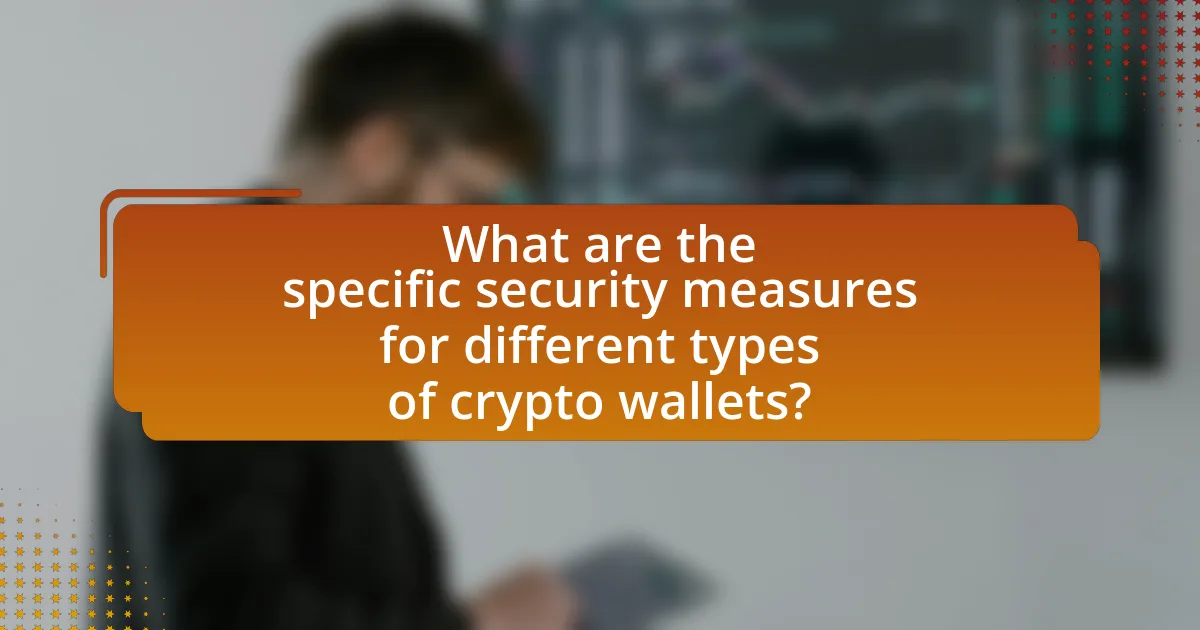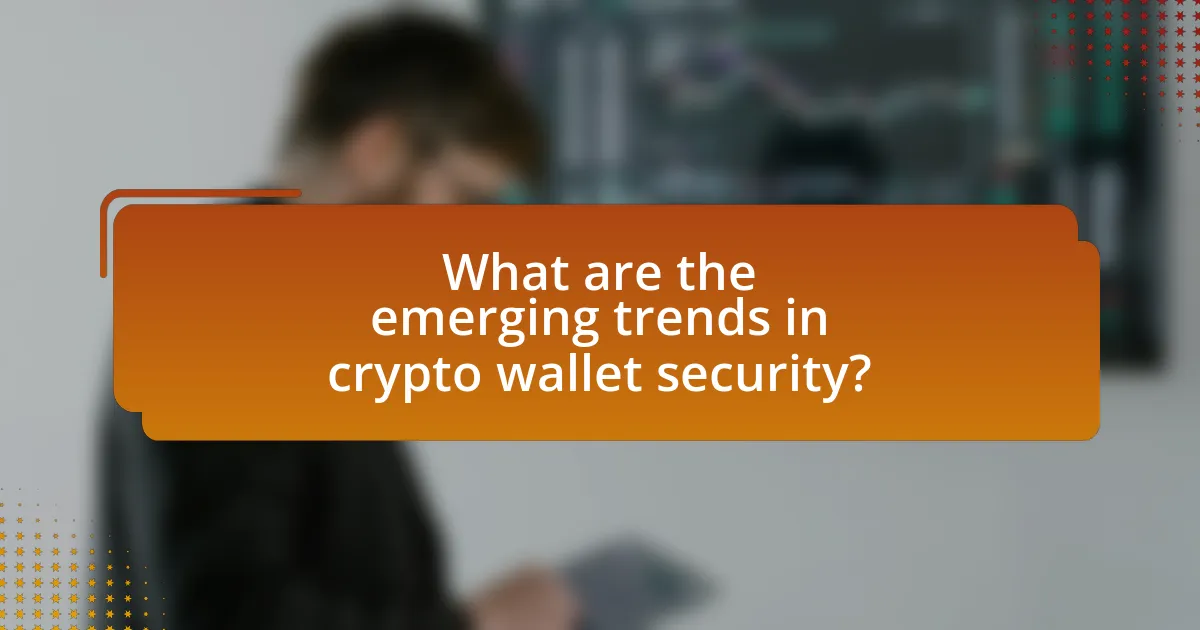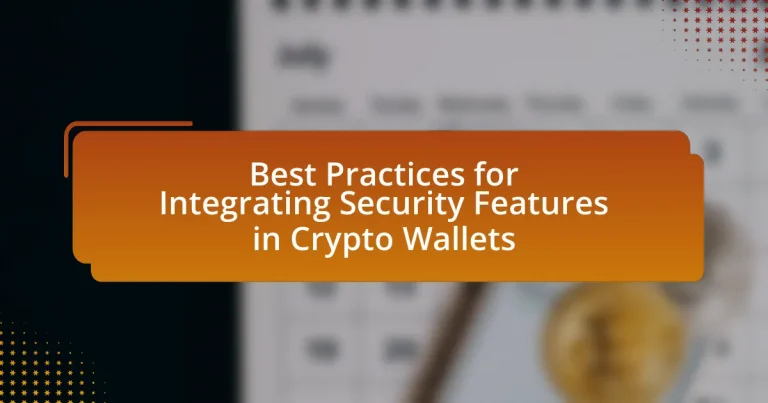The article focuses on best practices for integrating security features in crypto wallets, emphasizing the importance of robust security measures to protect digital assets. Key practices include implementing multi-factor authentication, utilizing hardware wallets for private key storage, and ensuring regular software updates to mitigate vulnerabilities. It also addresses common threats faced by crypto wallets, such as hacking and phishing attacks, and discusses the impact of security breaches on user trust and the broader cryptocurrency ecosystem. Additionally, the article outlines essential security features, coding practices for developers, and emerging trends in wallet security, including biometric authentication and decentralized solutions.

What are the Best Practices for Integrating Security Features in Crypto Wallets?
The best practices for integrating security features in crypto wallets include implementing multi-factor authentication (MFA), using hardware wallets for private key storage, and ensuring regular software updates. Multi-factor authentication significantly reduces the risk of unauthorized access by requiring additional verification methods beyond just a password. Hardware wallets, which store private keys offline, provide a robust defense against online threats, as they are less susceptible to hacking. Regular software updates are crucial for patching vulnerabilities and enhancing security protocols, as evidenced by the fact that many security breaches occur due to outdated software. These practices collectively strengthen the security posture of crypto wallets, safeguarding users’ assets effectively.
Why is security crucial for crypto wallets?
Security is crucial for crypto wallets because they store private keys that grant access to digital assets. Without robust security measures, these wallets are vulnerable to hacking, theft, and unauthorized access, which can lead to significant financial losses. For instance, in 2021, over $2.8 billion was stolen from cryptocurrency exchanges and wallets due to security breaches, highlighting the importance of implementing strong security protocols. Effective security practices, such as two-factor authentication, encryption, and regular software updates, are essential to protect users’ funds and maintain trust in the cryptocurrency ecosystem.
What are the common threats faced by crypto wallets?
Crypto wallets face several common threats, including hacking, phishing attacks, malware, and loss of private keys. Hacking occurs when cybercriminals exploit vulnerabilities in wallet software or services to gain unauthorized access to funds. Phishing attacks trick users into revealing sensitive information, such as private keys or passwords, often through fake websites or emails. Malware can infect devices, allowing attackers to steal credentials or manipulate wallet transactions. Additionally, the loss of private keys, which are essential for accessing and managing crypto assets, can result in permanent loss of funds, as there is no recovery method for lost keys. These threats highlight the importance of implementing robust security measures in crypto wallets.
How do security breaches impact users and the crypto ecosystem?
Security breaches significantly undermine user trust and destabilize the crypto ecosystem. When breaches occur, users often face financial losses, as their assets can be stolen or compromised, leading to a decrease in confidence in digital currencies. For instance, the 2014 Mt. Gox hack resulted in the loss of approximately 850,000 Bitcoins, which severely impacted user sentiment and market stability. Additionally, security breaches can lead to regulatory scrutiny, prompting governments to impose stricter regulations on the crypto industry, which can stifle innovation and growth. Overall, the ramifications of security breaches extend beyond individual losses, affecting the broader integrity and adoption of cryptocurrencies.
What key security features should be integrated into crypto wallets?
Key security features that should be integrated into crypto wallets include multi-factor authentication (MFA), encryption, and backup recovery options. Multi-factor authentication enhances security by requiring users to provide two or more verification factors, significantly reducing the risk of unauthorized access. Encryption protects sensitive data stored within the wallet, ensuring that even if the wallet is compromised, the information remains secure. Backup recovery options allow users to restore their wallets in case of loss or theft, providing an essential safety net. These features collectively strengthen the overall security posture of crypto wallets, making them more resilient against potential threats.
What role does two-factor authentication play in wallet security?
Two-factor authentication (2FA) significantly enhances wallet security by requiring two forms of verification before granting access. This additional layer of security mitigates the risk of unauthorized access, as even if a password is compromised, the attacker would still need the second factor, typically a code sent to a mobile device or generated by an authentication app. According to a study by Google, implementing 2FA can block 99.9% of automated attacks, demonstrating its effectiveness in protecting sensitive information in crypto wallets.
How can encryption enhance the security of crypto wallets?
Encryption enhances the security of crypto wallets by protecting sensitive data, such as private keys and transaction information, from unauthorized access. By employing strong encryption algorithms, crypto wallets ensure that even if data is intercepted, it remains unreadable without the correct decryption key. For instance, AES (Advanced Encryption Standard) is widely used in crypto wallets to secure user data, making it significantly more difficult for hackers to compromise wallet security. This layer of protection is crucial, as it mitigates risks associated with data breaches and cyberattacks, thereby safeguarding users’ digital assets.
How can developers ensure secure coding practices for crypto wallets?
Developers can ensure secure coding practices for crypto wallets by implementing rigorous security protocols, including input validation, secure key management, and regular code audits. Input validation prevents injection attacks by ensuring that only properly formatted data is processed, while secure key management involves using hardware security modules or secure enclaves to protect private keys. Regular code audits, including static and dynamic analysis, help identify vulnerabilities early in the development process. According to the OWASP Top Ten, failure to implement these practices can lead to significant security breaches, emphasizing their importance in safeguarding crypto wallets.
What are the best coding practices to prevent vulnerabilities?
The best coding practices to prevent vulnerabilities include input validation, proper error handling, and secure coding techniques. Input validation ensures that only correctly formatted data is processed, reducing the risk of injection attacks. Proper error handling prevents the exposure of sensitive information through error messages, which could be exploited by attackers. Secure coding techniques, such as using prepared statements for database queries and employing encryption for sensitive data, further mitigate risks. According to the OWASP Top Ten, implementing these practices significantly decreases the likelihood of common vulnerabilities, such as SQL injection and cross-site scripting, thereby enhancing the overall security of applications, including crypto wallets.
How can regular security audits improve wallet safety?
Regular security audits significantly enhance wallet safety by identifying vulnerabilities and ensuring compliance with security standards. These audits systematically evaluate the wallet’s code, architecture, and operational procedures, allowing for the detection of potential security flaws before they can be exploited. For instance, a study by the International Journal of Information Security found that organizations conducting regular security audits reduced their risk of data breaches by up to 50%. By addressing identified weaknesses promptly, wallets can maintain a robust defense against evolving cyber threats, thereby safeguarding users’ assets more effectively.

What are the specific security measures for different types of crypto wallets?
The specific security measures for different types of crypto wallets include hardware wallets, software wallets, and paper wallets, each employing distinct strategies. Hardware wallets utilize secure elements and offline storage to protect private keys from online threats, ensuring that keys never leave the device. Software wallets implement encryption, two-factor authentication, and regular software updates to safeguard against malware and unauthorized access. Paper wallets, while inherently secure from online attacks, require careful handling and storage to prevent physical theft or damage, emphasizing the importance of secure physical environments. These measures are validated by industry standards and best practices, which recommend multi-layered security approaches to mitigate risks associated with cryptocurrency storage.
How do hardware wallets differ in security from software wallets?
Hardware wallets provide superior security compared to software wallets by storing private keys offline, which significantly reduces the risk of hacking. Software wallets, being connected to the internet, are more vulnerable to malware and phishing attacks, as they require the private keys to be stored on devices that can be compromised. In contrast, hardware wallets utilize secure elements and encryption to protect private keys, making unauthorized access extremely difficult. This distinction is supported by the fact that hardware wallets are designed specifically to resist physical and digital attacks, while software wallets lack this level of protection, leading to higher instances of theft and loss in the crypto space.
What unique security features do hardware wallets offer?
Hardware wallets offer unique security features such as offline storage, which protects private keys from online threats. By keeping private keys stored in a secure, isolated environment, hardware wallets significantly reduce the risk of hacking and malware attacks that can compromise software wallets. Additionally, hardware wallets often include secure elements that provide tamper resistance and encryption, ensuring that even if the device is physically accessed, the data remains protected. These features are validated by the fact that hardware wallets are widely regarded as one of the safest options for storing cryptocurrencies, as evidenced by their use in securing billions of dollars in digital assets globally.
How can software wallets implement robust security measures?
Software wallets can implement robust security measures by utilizing multi-factor authentication (MFA), encryption, and regular software updates. Multi-factor authentication adds an extra layer of security by requiring users to provide two or more verification factors to gain access, significantly reducing the risk of unauthorized access. Encryption protects sensitive data by converting it into a secure format that can only be read by authorized users, ensuring that even if data is intercepted, it remains unreadable. Regular software updates are crucial as they patch vulnerabilities and enhance security features, keeping the wallet resilient against emerging threats. According to a report by the Cybersecurity & Infrastructure Security Agency, implementing these measures can reduce the likelihood of successful cyberattacks on digital wallets.
What are the best practices for user education on wallet security?
The best practices for user education on wallet security include providing clear guidelines on creating strong passwords, emphasizing the importance of two-factor authentication, and educating users about phishing attacks. Strong passwords should be at least 12 characters long, combining letters, numbers, and symbols, as studies show that complex passwords significantly reduce the risk of unauthorized access. Two-factor authentication adds an additional layer of security, making it harder for attackers to gain access even if they have the password. Furthermore, educating users about phishing attacks, which accounted for 90% of data breaches in 2020 according to the Verizon Data Breach Investigations Report, helps them recognize and avoid potential scams. Regular updates and reminders about security practices also reinforce safe behaviors among users.
How can users recognize phishing attempts related to crypto wallets?
Users can recognize phishing attempts related to crypto wallets by identifying suspicious emails, messages, or websites that request sensitive information. Common indicators include poor spelling and grammar, generic greetings, and URLs that do not match the official website of the wallet provider. For instance, legitimate communications from wallet services typically use personalized greetings and official domain names. According to a report by the Anti-Phishing Working Group, phishing attacks targeting cryptocurrency users have increased significantly, highlighting the importance of vigilance against such tactics.
What resources are available for educating users about wallet security?
Resources available for educating users about wallet security include official documentation from wallet providers, online courses, and cybersecurity websites. For instance, many cryptocurrency wallet providers, such as Coinbase and Ledger, offer comprehensive guides and FAQs that detail best practices for securing wallets. Additionally, platforms like Coursera and Udemy provide courses focused on cryptocurrency security, which cover wallet safety. Cybersecurity organizations, such as the Cybersecurity & Infrastructure Security Agency (CISA), also publish resources and tips on securing digital assets. These resources collectively help users understand the importance of wallet security and implement effective protective measures.

What are the emerging trends in crypto wallet security?
Emerging trends in crypto wallet security include the adoption of multi-signature authentication, biometric security measures, and decentralized wallet solutions. Multi-signature authentication enhances security by requiring multiple private keys to authorize a transaction, significantly reducing the risk of unauthorized access. Biometric security measures, such as fingerprint and facial recognition, are increasingly integrated into wallets to provide an additional layer of protection against theft. Decentralized wallet solutions, which store private keys on the user’s device rather than on centralized servers, mitigate risks associated with hacking and data breaches. These trends reflect a growing emphasis on user control and enhanced security in the evolving landscape of cryptocurrency.
How is biometric authentication shaping the future of wallet security?
Biometric authentication is significantly enhancing wallet security by providing a unique and personal method of user verification. This technology utilizes physical characteristics, such as fingerprints or facial recognition, which are difficult to replicate or steal compared to traditional passwords. According to a report by the International Journal of Information Management, biometric systems can reduce fraud by up to 99% when integrated into financial applications. As a result, the adoption of biometric authentication in crypto wallets is expected to increase, offering users a more secure and convenient way to access their digital assets while minimizing the risk of unauthorized access.
What are the advantages and challenges of using biometrics?
Biometrics offer advantages such as enhanced security and user convenience, while challenges include privacy concerns and potential for false positives. Enhanced security arises from the uniqueness of biometric traits, making unauthorized access significantly harder; for instance, fingerprint recognition systems have a false acceptance rate of less than 0.01%. However, privacy concerns stem from the sensitive nature of biometric data, which can be misused if compromised. Additionally, challenges like false positives can lead to legitimate users being denied access, impacting user experience.
How can biometric features be integrated without compromising user privacy?
Biometric features can be integrated without compromising user privacy by employing techniques such as local processing, data anonymization, and secure storage. Local processing ensures that biometric data is analyzed on the user’s device rather than transmitted to external servers, minimizing exposure to potential breaches. Data anonymization techniques can obscure identifiable information, allowing for the use of biometric features while protecting user identities. Additionally, secure storage methods, such as encryption, can safeguard biometric data, ensuring that even if data is stored, it remains inaccessible without proper authorization. These practices align with privacy regulations and enhance user trust in biometric implementations.
What role does blockchain technology play in enhancing wallet security?
Blockchain technology significantly enhances wallet security by providing a decentralized and immutable ledger for transactions. This decentralization reduces the risk of single points of failure, as data is distributed across a network of nodes, making it difficult for malicious actors to alter transaction records. Additionally, the cryptographic techniques used in blockchain, such as hashing and public-private key pairs, ensure that only authorized users can access and manage their wallets. For instance, the use of cryptographic signatures verifies the authenticity of transactions, preventing unauthorized access and fraud. These features collectively contribute to a robust security framework that protects users’ digital assets from theft and manipulation.
How can smart contracts improve the security of transactions?
Smart contracts enhance the security of transactions by automating and enforcing the terms of agreements without the need for intermediaries. This automation reduces the risk of human error and fraud, as the contract executes predefined conditions automatically when triggered. For instance, once a smart contract is deployed on a blockchain, it becomes immutable, meaning that its code cannot be altered, which protects against tampering. Additionally, the transparency of blockchain technology allows all parties to verify the contract’s terms and execution, further ensuring trust and security in the transaction process.
What are the implications of decentralized wallets for security practices?
Decentralized wallets enhance security practices by eliminating the need for a central authority, thereby reducing the risk of hacks and data breaches associated with centralized systems. Users maintain control over their private keys, which minimizes the likelihood of unauthorized access. According to a report by the Blockchain Research Institute, decentralized wallets significantly lower the attack surface for cybercriminals, as there is no single point of failure. Furthermore, the use of cryptographic techniques in decentralized wallets ensures that transactions are secure and verifiable, reinforcing user trust and the integrity of the wallet system.
What practical tips can users follow to enhance their wallet security?
To enhance wallet security, users should implement strong, unique passwords and enable two-factor authentication (2FA). Strong passwords reduce the risk of unauthorized access, while 2FA adds an additional layer of protection by requiring a second form of verification, such as a code sent to a mobile device. According to a study by the Cybersecurity & Infrastructure Security Agency, using 2FA can block 99.9% of automated attacks. Additionally, users should regularly update their wallet software to protect against vulnerabilities, as outdated software can be an easy target for hackers. Keeping backup recovery phrases secure and offline further safeguards against loss or theft.
How can users create strong passwords for their wallets?
Users can create strong passwords for their wallets by combining a mix of uppercase and lowercase letters, numbers, and special characters, ensuring a minimum length of 12 characters. This complexity makes it significantly harder for attackers to guess or crack the password, as studies show that longer and more varied passwords exponentially increase security. Additionally, using passphrases—longer phrases made up of random words—can enhance memorability while maintaining strength. According to the National Institute of Standards and Technology (NIST), avoiding common words and predictable patterns is crucial in password creation, as these are often the first targets for brute-force attacks.
What steps should users take to secure their recovery phrases?
Users should take several steps to secure their recovery phrases, including writing them down on paper and storing them in a safe location, such as a safe deposit box or a fireproof safe. This method prevents digital theft, as recovery phrases stored online are vulnerable to hacking. Additionally, users should avoid sharing their recovery phrases with anyone and refrain from storing them on devices connected to the internet, which can be compromised. Implementing these practices significantly reduces the risk of unauthorized access to cryptocurrency wallets, as evidenced by numerous cases where stolen recovery phrases led to significant financial losses.


